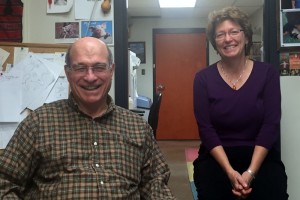Drs. Lorinda Anderson and Stephen Stack will travel to St. Petersburg, Russia later in October to present two seminars each at St. Petersburg State University. Dr. Stack will focus his talks on the lab’s extensive work in the sequencing of the tomato genome and on genetic recombination in maize, and Dr. Anderson will focus her talks on genetic recombination in tomato.
This international scientific exchange is the result of a working collaboration that began back in 1999. At that time, Dr. Stack applied for a supplemental grant through the NSF to support international collaborations. When it was awarded, Dr. Anderson and Dr. Stack invited Dr. Elena Mikhailova from Saint Petersburg State University, who works on genetic recombination in rye, to visit their lab to learn new research techniques. As part of the arrangement, Drs. Anderson and Stack traveled to Russia where they visited with Dr. Mikhailova and other scientists in St. Petersburg and with Dr. Yuri Bogdanov and his colleagues in Moscow.
Recently, Dr. Mikhailova applied to the Dynasty Foundation for funds to bring Dr. Stack and Dr. Anderson to visit Russia again. The Dynasty Foundation is the first private, non-profit foundation to support science and education in Russia. Established by Dmitry Zimin, it offers support for contemporary science in Russia and funds collaborative visits between international scientists. Unfortunately for the science community in Russia, the foundation will terminate on Oct. 31 of this year.
Recalling that first visit, Anderson and Stack spoke of the wonders of St. Petersburg, including the magnificent architecture, the museums, the churches, and the intricate mosaics. A favorite was the massive Winter Palace, the official residence of monarchs between 1732 and the revolution in 1917. For many years, St. Petersburg was designated as the capital of the Russian Empire. They described St. Petersburg as a very European city as contrasted to Moscow, which is very Russian. “The people on the street were quite elegantly dressed. You could tell we were Americans because we were so dressed so casually.”
They spoke of the generosity and kindness of the scientific community there as well as the delicious food. “They are really wonderful people, very welcoming. They are very proud of their scientific and cultural heritage.” said Dr. Anderson. During the first years of adjustment after the fall of the Soviet Union when research was not well-supported, the scholars and scientists persevered by sometimes working two or three extra jobs and coming in on their “free time” to do research.
Anderson and Stack did note the poor condition of the physical infrastructure at that time. Even though a highway may have had 10 lanes, 5 in each direction full of cars, there were no pollution controls. Driving behind a truck belching black smoke was an unpleasant experience, along with the many potholes.
But that was in the 1990’s. Eager to see the changes brought about through the intervening years, Anderson and Stack will spend their time sharing research and engaging with their scientific collaborators. The foundational work on genetic recombination and genome sequencing these labs engage in contributes significantly to agriculture. As Dr. Stack says, “We make the maps that others will use.”

